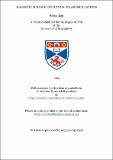Files in this item
Magnetic surface effects on solar oscillations
Item metadata
| dc.contributor.advisor | Roberts, Bernard | |
| dc.contributor.author | Jain, Rekha | |
| dc.coverage.spatial | 182 p. | en_US |
| dc.date.accessioned | 2018-06-18T09:15:28Z | |
| dc.date.available | 2018-06-18T09:15:28Z | |
| dc.date.issued | 1993 | |
| dc.identifier.uri | https://hdl.handle.net/10023/14153 | |
| dc.description.abstract | This thesis is concerned with the effects of magnetic atmospheres on solar oscillations. The behaviour of magnetohydrodynamic surface waves propagating on a single magnetic interface is discussed ignoring the effects of gravity. The effects of non-parallel propagation (where the wave vector is at an angle to the magnetic field direction) are considered. The effects of chromospheric magnetic fields on solar p- and f-modes in a stratified atmosphere are examined for three different models. In the first of these models, the chromosphere is assumed to be isothermal and permeated by a uniform and horizontal magnetic field. A dispersion relation for the p-modes trapped below such an atmosphere is derived. Asymptotic and numerical solutions for the p-modes are discussed in detail. An increase in chromospheric magnetic field strength leads to an increase in the frequency of the p-modes, whereas an increase in the chromospheric temperature leads to a decrease in the frequencies of these modes. Comparison with observational data suggests that both these effects may indeed take place. The second model is set up for magnetic fields which decrease with height in such a way that the Alfven speed remains constant. In addition to magnetic effects, the effects of non-parallel propagation on and f-modes are considered in the presence of such a non-uniform magnetic field. After deriving a very general dispersion relation, various asymptotic and numerical solutions have been obtained and the possible effects of magnetic fields and non-parallel propagation on these modes are examined. The presence of a horizontal non-uniform chromospheric field produces changes in the frequencies of the p- and f-modes, reducing the frequencies of p-modes and increasing the frequency of the f-mode. Besides depending upon magnetic field strength, frequencies also depend on both the mode's order n and its degree l. The effects of non-parallel propagation are found to be most significant for the f-mode and the low order p-modes. The magnetic structure of the chromosphere has been further generalised by combining the two models described above. In this three layer model, a dispersion relation is derived in a general manner and discussed in detail for the p-modes. The role of magnetoacoustic cut-off frequency is studied. Again, the results are qualitatively similar to those found from observation. | en_US |
| dc.language.iso | en | en_US |
| dc.publisher | University of St Andrews | en |
| dc.subject.lcc | QA927.J2 | |
| dc.subject.lcsh | Magnetohydrodynamic | en |
| dc.title | Magnetic surface effects on solar oscillations | en_US |
| dc.type | Thesis | en_US |
| dc.contributor.sponsor | University of St Andrews | en_US |
| dc.contributor.sponsor | Committee of Vice-Chancellors and Principals of the Universities of the United Kingdom | en_US |
| dc.type.qualificationlevel | Doctoral | en_US |
| dc.type.qualificationname | PhD Doctor of Philosophy | en_US |
| dc.publisher.institution | The University of St Andrews | en_US |
This item appears in the following Collection(s)
Items in the St Andrews Research Repository are protected by copyright, with all rights reserved, unless otherwise indicated.

